IMDb Data Analyzer
I love movies too!
There was a time when IMDb provided user statistics within our profiles, but unfortunately, that’s no longer the case.
So, I’ve decided to code a basic (and far from perfect) Python script to bring those statistics back to life, along with some additional ones.
If you have any suggestions for the code or the types of statistics to include, please let me know.
You can check out the code here
To the best of my knowledge, GitHub Pages, Jekyll, and Jupyter Notebooks do not integrate seamlessly.
To display the notebook shown below, I used the Anaconda Prompt to generate a markdown file by running the following command:
jupyter nbconvert --to markdown < file name >.ipynb
Between this method and converting the notebook to HTML, I prefer the former.
Import libraries and load the CSV file with ratings.
You can obtain the ratings file from your IMDb user account.
import pandas as pd
import numpy as np
import matplotlib.pyplot as plt
from datetime import date
ratings = pd.read_csv("ratings.csv")
print("Last updated:" + str(date.today()))
Last updated:2024-11-18
Parsing data.
Essentially, I will count the occurrences of each instance.
I am interested only in my own ratings, IMDb ratings, release year, and genres.
Please note that one movie can belong to multiple genres.
movie_idxs = ratings.index[ratings['Title Type']=='Movie'].tolist()
my_movie_ratings = ratings.iloc[movie_idxs,1]
counted_ratings = np.unique(my_movie_ratings, return_counts=True)
imdb_ratings = ratings.iloc[movie_idxs,7]
my_movie_years = ratings.iloc[movie_idxs,9]
counted_years = np.unique(my_movie_years, return_counts=True)
my_movie_runtimes = ratings.iloc[movie_idxs,8]
counted_runtimes = np.unique(my_movie_runtimes, return_counts=True)
my_movie_genres_aux = ratings.iloc[movie_idxs,10].str.split(", ") # the space after the comma is important
my_movie_genres = [item for sublist in my_movie_genres_aux for item in sublist]
counted_genres = np.unique(my_movie_genres, return_counts=True)
Plotting the distribution of my ratings.
The total number of movies I have given each score is indicated on top of each bar.
plt.figure(figsize=(6, 6), frameon=True)
plt.bar(counted_ratings[0], counted_ratings[1], color ='#4682B4', width = 0.5, edgecolor='wheat', linewidth=2)
plt.xlabel("My Rating")
plt.ylabel("Number of movies")
plt.xticks(counted_ratings[0])
for i in range(len(counted_ratings[0])):
plt.text(counted_ratings[0][i], counted_ratings[1][i] + 10,
str(counted_ratings[1][i]))
plt.title("I have watched a total of %d movies" %(sum(counted_ratings[1][:])))
plt.show()
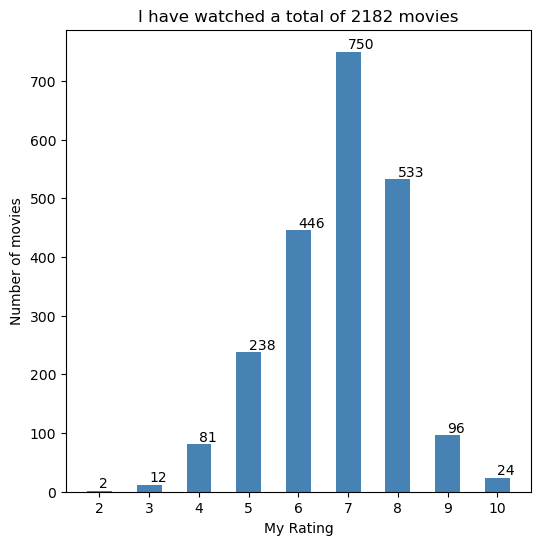
Plotting information about the genres.
For better visualization, I will group less-watched genres into Others and limit the pie chart to eight wedges.
The popularity of each genre in the Others category is listed in the table below.
genres_dataframe = pd.DataFrame(
data = {
'Genre': counted_genres[0].tolist(),
'value' : counted_genres[1].tolist()},
).sort_values('value', ascending = False)
# The top 7 most watched genres
genres_dataframe_most_watched = genres_dataframe[:7].copy()
# The remaining genres are summed up altogether
genres_dataframe_others = pd.DataFrame(data = {
'Genre' : ['Others'],
'value' : [genres_dataframe['value'][7:].sum()]
})
# Combine dataframes
genres_dataframe_compact = pd.concat([genres_dataframe_most_watched, genres_dataframe_others])
# I like blue :)
color_shades = ['#728FCE','#4863A0','#2B547E','#36454F', '#29465B','#2B3856','#123456', '#151B54']
fig, ax = plt.subplots(figsize=(6, 6))
patches, texts, pcts = ax.pie(
genres_dataframe_compact['value'], labels=genres_dataframe_compact['Genre'].tolist(), autopct='%.1f%%',
colors=color_shades,
wedgeprops={'linewidth': 2.0, 'edgecolor': 'wheat'},
textprops={'size': 'large', 'fontweight': 'bold'})
# Set the corresponding text label color to the wedge's face color.
for i, patch in enumerate(patches):
texts[i].set_color(patch.get_facecolor())
plt.setp(pcts, color='white')
plt.setp(texts, fontweight='bold')
ax.set_title('Most watched genres', fontsize=18)
plt.tight_layout()
plt.show()
genres_dataframe_less_watched = genres_dataframe[7:].copy()
genres_dataframe_less_watched.rename(columns = {'value':'Movies watched'}, inplace = True)
genres_dataframe_less_watched.style.set_table_styles(
[
{
'selector': 'th',
'props': [('background-color', '#D3D3D3')]
},
]
)
print(genres_dataframe_less_watched.to_string(index=False))
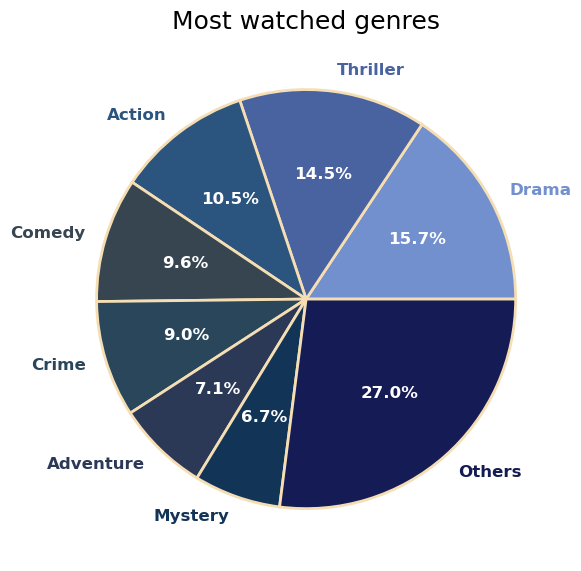
Genre Movies watched
Sci-Fi 401
Romance 297
Fantasy 284
Horror 264
Family 179
Biography 131
Animation 117
War 85
History 78
Western 37
Sport 34
Documentary 31
Music 30
Musical 28
Film-Noir 14
In the following, I will plot the average rate for each genre.
plt.figure(figsize=(6, 6))
plt.xlabel("Genre")
plt.ylabel("Average rating")
my_avg_genre_rating = np.zeros([len(counted_genres[0])]) # Empty array
imdb_avg_genre_rating = np.zeros([len(counted_genres[0])]) # Empty array
for i, genre in enumerate(counted_genres[0]):
for k in range(len(ratings['Genres'])):
if (genre in str(ratings['Genres'][k])) and str(ratings['Title Type'][k]) == 'Movie':
if genre == 'Music' and 'Musical' in str(ratings['Genres'][k]):
# I am sure there's a better way to perform these loops :)
pass
else:
my_avg_genre_rating[i] += ratings['Your Rating'][k]
imdb_avg_genre_rating[i] += ratings['IMDb Rating'][k]
my_avg_genre_rating[i] = my_avg_genre_rating[i]/counted_genres[1][i]
imdb_avg_genre_rating[i] = imdb_avg_genre_rating[i]/counted_genres[1][i]
x_axis = np.arange(len(counted_genres[0]))
plt.bar(x_axis + 0.2, my_avg_genre_rating, width=0.4, label = 'Mine', color="#002c5a",edgecolor="sienna")
plt.bar(x_axis - 0.2, imdb_avg_genre_rating, width=0.4, label = 'IMDb', color="#96caff",edgecolor="maroon")
plt.xticks(x_axis,counted_genres[0])
plt.xticks(rotation=90)
plt.legend()
plt.grid(color = 'green', linestyle = '--', linewidth = 0.5)
plt.grid(axis = 'x')
plt.ylim([0, 10])
plt.show()
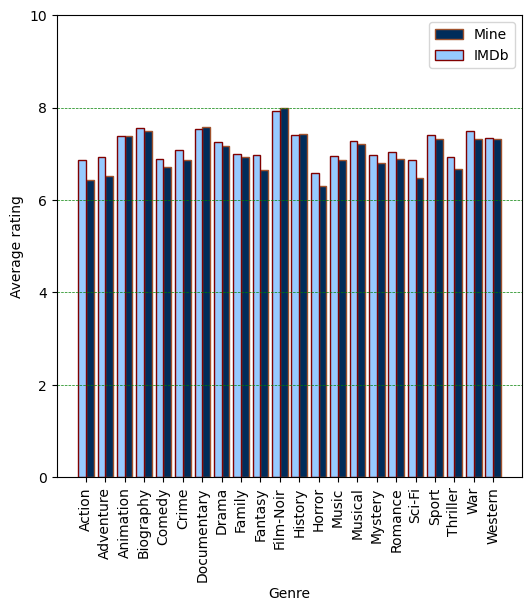
As somewhat expected for someone born in 1990, I have been watching more recent movies.
Additionally, only a few classics have stood the test of time.
plt.figure(figsize=(6, 6))
plt.bar(counted_years[0], counted_years[1], color ='#4682B4', width = 0.5, edgecolor="maroon",linewidth = 0.3)
plt.xlabel("Release year")
plt.ylabel("Number of movies")
plt.title("Release year of movies I've watched")
for i in range(0, len(counted_years[0]),5):
plt.text(counted_years[0][i], counted_years[1][i] + 0.5,
str(counted_years[1][i]),color='crimson',fontweight='bold')
plt.grid(color = 'blue', linestyle = '--', linewidth = 0.2)
plt.show()
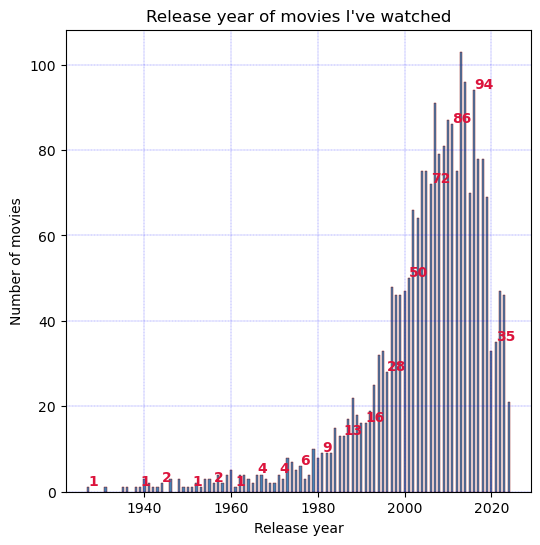
Let’s now take a look at the average ratings as a function of release year.
my_avg_rating = np.empty([len(counted_years[0])]) # Empty array
imdb_avg_rating = np.empty([len(counted_years[0])]) # Empty array
for i in range(len(counted_years[0])):
idxs = my_movie_years == counted_years[0][i]
my_avg_rating[i] = np.mean(my_movie_ratings[idxs])
imdb_avg_rating[i] = np.mean(imdb_ratings[idxs])
avg_ratings_df = pd.DataFrame({
'Year': counted_years[0],
'My Average Rating': my_avg_rating,
'IMDb Average Rating': imdb_avg_rating
})
# plotting graph
ax = avg_ratings_df.plot(x="Year", y=["My Average Rating", "IMDb Average Rating"], kind="bar", figsize=(20, 6),
subplots=False,
grid=True,
color={"My Average Rating": "#002c5a", "IMDb Average Rating": "#96caff"})
ax.set_axisbelow(True)
ax.grid(color='r', linestyle='--', linewidth=0.5)
ax.grid(axis='x')
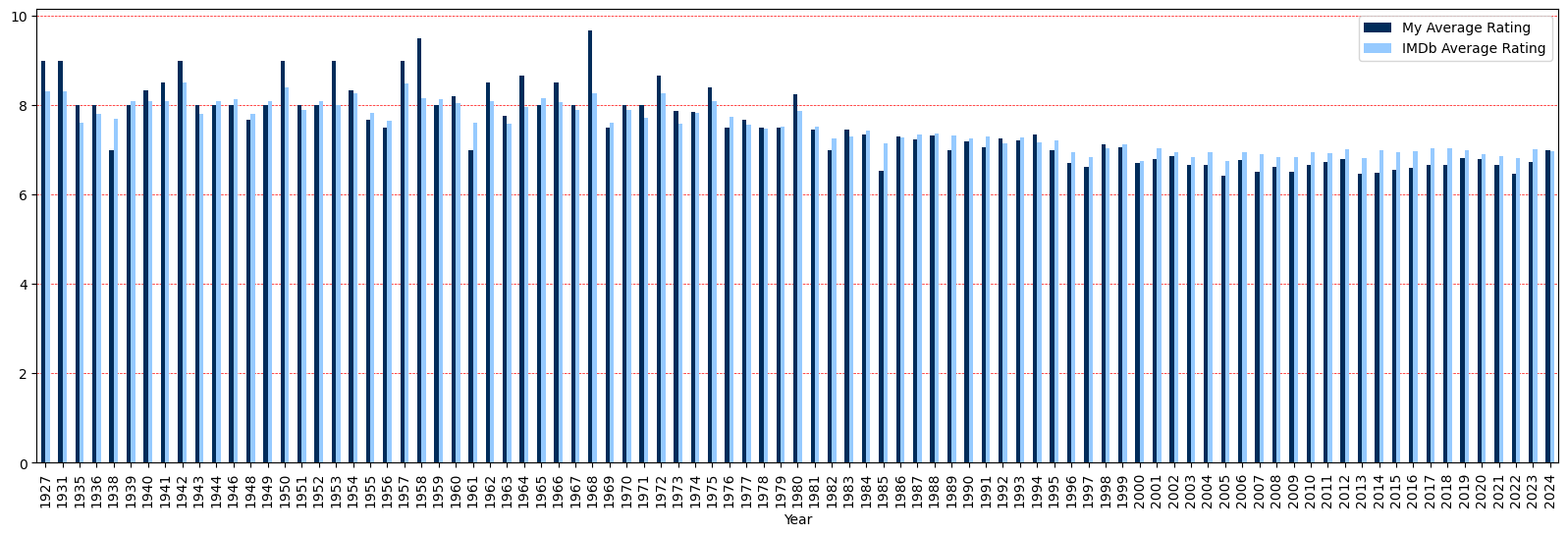
Let’s now see how aligned I am with the masses.
It seems that we generally agree on the 7’s.
plt.figure(figsize=(6, 6))
plt.scatter(my_movie_ratings, imdb_ratings, alpha=0.5, edgecolors="k")
m, b = np.polyfit(my_movie_ratings, imdb_ratings, deg=1)
# Create a sequence of 50 points from 2 to 10
sequence_x = np.linspace(counted_ratings[0][0], counted_ratings[0][-1], num=50)
# Plot regression line
plt.plot(sequence_x, b + m * sequence_x, color="dodgerblue", linestyle = '--', lw=1.5)
# Plot y = x line
plt.plot(sequence_x, sequence_x, color="darkgoldenrod", linestyle = '--', lw=1.5)
mean_rating = np.empty([len(counted_ratings[0])]) # Empty array
std_rating = np.empty([len(counted_ratings[0])]) # Empty array
for i in range(len(counted_ratings[0])):
idxs = my_movie_ratings == counted_ratings[0][i]
imdb_ratings_aux = imdb_ratings[idxs]
mean_rating[i] = np.mean(imdb_ratings_aux)
std_rating[i] = np.std(imdb_ratings_aux)
plt.scatter(counted_ratings[0], mean_rating, color="crimson",edgecolors="orange")
plt.errorbar(counted_ratings[0], mean_rating, std_rating, fmt="o", color="r")
plt.xlabel('My rating')
plt.ylabel('IMDb rating')
plt.title('How much do I agree with IMDb ratings?')
plt.grid(color = 'blue', linestyle = '--', linewidth = 0.2)
plt.show()


 Macau, China
Macau, China